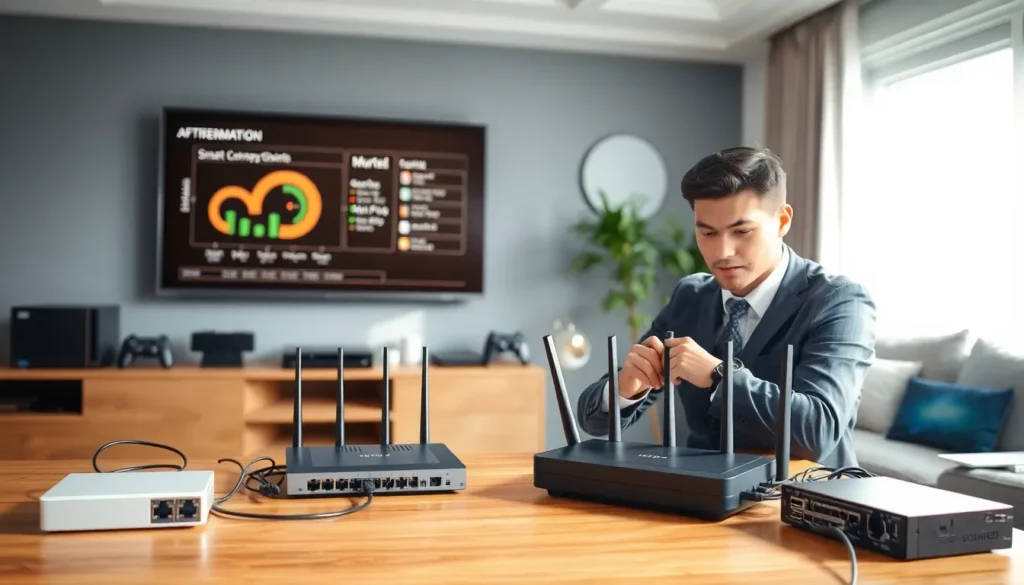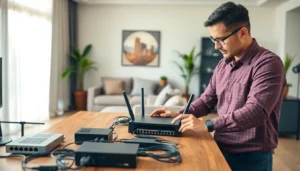Table of Contents
ToggleIn today’s tech-driven world, a reliable home networking service is as essential as having a refrigerator, yet somehow, it often gets treated like the forgotten cousin at Thanksgiving dinner. Everyone needs it, but not everyone knows how to set it up properly. Whether streaming your favorite show, attending a virtual meeting, or battling online in the latest gaming craze, your home network serves as the unsung hero. So, let’s dive deep into the world of home networking and find out how to optimize it like a pro.
What Is Home Networking?

Home networking refers to the connectivity system that links multiple devices within a household, allowing them to communicate with one another. This network enables devices such as computers, smartphones, smart TVs, and gaming consoles to share resources like internet access, files, and printers. Think of it as the matchmaking service for your devices: it ensures they play well together without any awkward silences or dropped connections.
Simply put, a home network can be wired or wireless. Wired networks are faster and more secure, but they can be a bit of a hassle to set up. On the other hand, wireless networks provide the convenience of mobility, allowing users to enjoy internet access anywhere within their home. With the rise of smart home devices, having a robust home network has become increasingly important.
Key Components of Home Networking
Before setting up a home network, one must understand its key components. Here’s a quick rundown:
- Modem: The modem connects your home network to your Internet Service Provider (ISP). It is the gateway that lets your home access the internet.
- Router: The router takes the internet signal from the modem and distributes it to devices in your home. Think of it as the traffic cop of internet connectivity, making sure all data packets get to the right address.
- Switch: While not always necessary, switches allow additional devices to connect through wired connections, increasing the number of available ports beyond what a router provides.
- Access Point: This extends your wireless network range. It’s like giving your Wi-Fi a bit of a turbo boost to reach every corner of your home.
- Network Cables: These cables connect everything together in a wired network. They may not be glamorous, but good-quality cables mean fewer dropped connections.
Types of Home Networking Services
When considering home networking services, there are a few options to keep in mind:
- Basic Networking Setup: Ideal for smaller households, this service provides essential installation and configuration of routers and basic networking equipment.
- Advanced Networking Solutions: Tailored for tech-savvy users or bigger homes, this includes advanced setups with multiple access points, switches, and tailored configurations for optimal performance.
- Smart Home Integration: As smart devices continue to infiltrate homes, this service offers integration solutions that allow various smart devices to communicate seamlessly.
- Security Services: With data breaches becoming increasingly common, security-focused services provide comprehensive measures to protect your home network from threats.
- Ongoing Maintenance & Support: Staying connected means staying updated. Professional services often include ongoing support and maintenance plans to keep everything running smoothly.
Benefits of Professional Home Networking Services
Choosing a professional home networking service offers numerous advantages:
- Expertise: Professionals come with the knowledge and experience necessary to optimize network setups for speed, reliability, and coverage.
- Time-Saving: Setting up a home network can be time-consuming. A pro quickly and efficiently handles the work, freeing individuals to focus on their day-to-day lives.
- Reduced Stress: Explained simply: no more troubleshooting confusion late at night. Professionals streamline the setup and can swiftly resolve issues if things go wrong.
- Custom Solutions: Every home is different. Experts tailor networking solutions based on individual needs, ensuring optimal performance and security.
- Future-Proofing: Technology evolves rapidly. Keeping pace with advancements means relying on professionals to integratively update networking systems, ensuring longevity and efficiency.
How to Choose the Right Home Networking Service Provider
Selecting the ideal home networking service provider can feel overwhelming. Here are some tips:
- Assess Your Needs: Are you a casual user or a tech aficionado? Understanding what you need from a network helps narrow down options.
- Research Reputation: Look up reviews and customer testimonials. A provider with a good reputation often delivers reliable service.
- Evaluate Service Offerings: Ensure that providers offer services pertinent to your needs, such as installation, support, or maintenance.
- Inquire About Support: Opt for a company that offers robust post-installation support. You never know when a hiccup will occur.
- Compare Prices: Don’t hesitate to request quotes from multiple providers to find the best deal without sacrificing quality.
Common Challenges and Solutions in Home Networking
Even the best home networks can face challenges. Here are some common issues and their solutions:
- Weak Wi-Fi Signals: If the Wi-Fi doesn’t reach certain rooms, consider adding access points or range extenders.
- Slow Speeds: Ensure that your router can handle the number of devices connected. Upgrading to a better model may resolve speed issues.
- Connection Drops: This could be due to an overloaded network. Verifying bandwidth usage or upgrading your plan with your ISP can help alleviate the issue.
- Security Risks: Regularly updating passwords and using secure protocols will keep unauthorized users at bay. It’s wise to also invest in network security services that provide constant monitoring.




